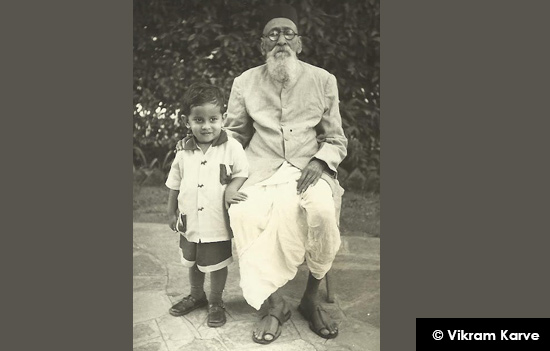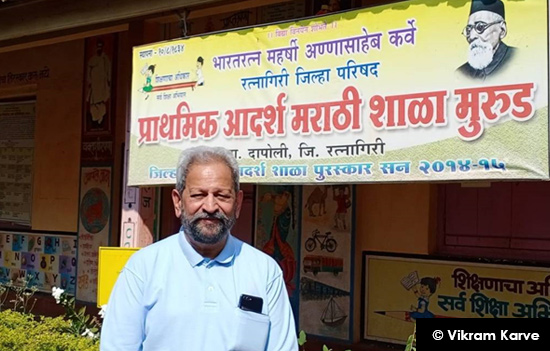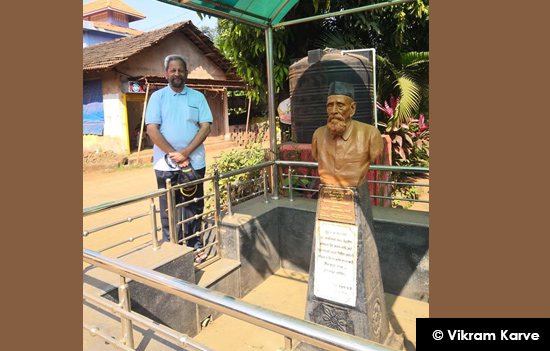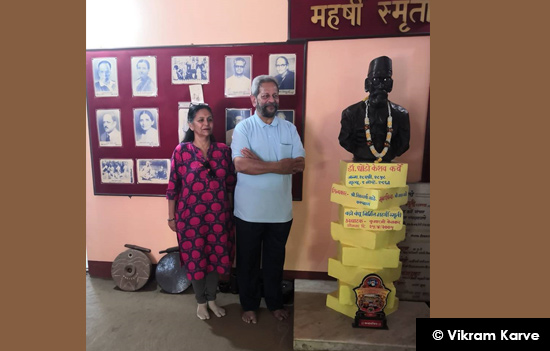This is a book review of Looking Back which has the life story of the great reformer Maharshi Karve who also founded SNDT University, Mumbai amongst others. It is written by his great grandson Vikram.
The book ‘Looking Back was written by DK Karve in 1936. It is an Autobiography of Bharat Ratna Maharshi Dhondo Keshav Karve.
The 9th of November is the पुण्यतिथि
(Death Anniversary) of Maharshi Karve (18.04.1858 to 09.11.1962)
I feel that on this occasion it would be
apt to tell you about his life and work as written by him in his autobiography
titled LOOKING BACK published in 1936.
Dear Reader,
You must be wondering why I am reviewing
an autobiography written in 1936.
Well around 20 years ago, from 2000 to
2006 i.e. for 6 years, I stayed in a magnificent building called Empress Court
on Maharshi Karve Road opposite the Oval at Churchgate in Mumbai.
I share the same surname (Karve) as the
author. Also, I happen to be the great-grandson of Maharshi Dhondo Keshav
Karve. But, beyond that, compared to him I am not even a pygmy.
Maharshi Karve clearly knew his goal,
persisted ceaselessly throughout his life with missionary zeal and transformed
the destiny of Indian Women.
The first university for women in India,
SNDT Women’s University and
educational institutions for women under the aegis of the Hingne Stree Shikshan Samstha Poona, later renamed Maharshi Karve Stree Shikshan Samstha
(MKSSS) Pune, covering the entire spectrum ranging from pre-primary schools to
post-graduate, engineering, vocational and professional colleges-all these
institutions bear eloquent testimony to his indomitable spirit, untiring
perseverance and determined efforts.
LOOKING BACK by DK KARVE (1936), BOOK
REVIEW
In his preface Frederick J Gould, renowned rationalist and lecturer on Ethics, writes that “the narrative is a parable of his career” — a most apt description of the autobiography.
The author tells his life-story in a
simple straightforward manner, with remarkable candour and humility-resulting
in a narrative which is friendly, interesting and readable.
Autobiographies are sometimes voluminous
tomes but this a small book, just 200 pages.
It is a very easy comfortable enjoyable read — written from the heart in engrossing storytelling style — that makes the book unputdownable.
Maharshi Karve writes a crisp, flowing narrative of his life, interspersed with his views and anecdotes — in simple, straightforward style — which facilitates the reader to visualize through the author’s eyes the places, period, people and events pertaining to his life and times and the trials and tribulations he faced and struggled to conquer.
Dr. Dhondo Keshav Karve was born on 18th
of April 1858.
In the first few chapters he writes about Murud, his native place in Konkan, Maharashtra-his ancestry and his early life-the description is so vivid that you can clearly “see” through the author’s eye.
His struggle to appear in the public
service examination (walking 110 miles in
torrential rain and difficult terrain to Satara) - and his disappointment at not being allowed to appear for the exam because “he looked too young” make poignant reading.
“Many undreamt of things have happened in my life and given a different turn to my career” he writes — and then — he goes on to describe his high school — and later — his college education at The Wilson College Bombay (Mumbai) — narrating various incidents that convinced him of the role of destiny — and the role of serendipity in shaping his life and career as a teacher and then Professor of Mathematics.
He married at the age of 14 — but began his marital life at the age of 20…!!! This was the custom of those days.
Let’s read the author’s own words on his domestic life:
“… I was married at the age of fourteen and my wife was then eight. Her family lived very near to ours and we knew each other very well and had often played together. However after marriage we had to forget our old relation as playmates and to behave as strangers, often looking toward each other but never standing together to exchange words … We had to communicate with each other through my sister … My marital life began under the parental roof at Murud when I was twenty…”
Their domestic bliss was short lived — as his wife died after a few years leaving behind a son. “Thus ended the first part of my domestic life…” he concludes in crisp witty style.
An incident highlighting the plight of a
widow left an indelible impression on him and germinated in him the idea of
widow remarriage.
He married Godubai who was widowed when she was only eight years old. She was the sister of his friend Mr. Joshi. She was now a 23 years old widow, studying at Pandita Ramabai’s Sharada Sadan as its first widow student.
Let’s read in the author’s own words how he asked for her hand in marriage to her father:
“I told him-I had made up my mind to marry a widow. He sat silent for a minute and then hinted that there was no need to go in search of such a bride…”
He describes in detail the ostracism he faced from some orthodox quarters and systematically enunciates his life work-his organization of the Widow Marriage Association, Hindu Widows Home, Mahila Vidyalaya, Nishkama Karma Math, and other institutions, culminating in the birth of the first Indian Women’s University (SNDT University).
The trials and tribulations he faced in
his life-work of emancipation of education of women (widows in particular) and
how he overcame them by his persistent steadfast endeavours and indomitable
spirit makes illuminating reading and underlines the fact that Dr. DK Karve was
no arm-chair social reformer but a person devoted to achieve his dreams on the
ground in reality.
 Author with Maharshi Karve.
Author with Maharshi Karve.
These chapters form the
meat of the book and make compelling reading.
His dedication and meticulousness is
evident in the appendices where he has given date-wise details of his engagements
and subscriptions down to the paisa for his educational institutions from
various places he visited around the world to propagate their cause.
He then describes his world tour, at the ripe age of 71, to meet eminent educationists to propagate the cause of the Women’s University, his later domestic life and ends with a few of his views and ideas for posterity.
At the end of the book, concluding his
autobiography, he writes:
“Here ends the story of my life. I hope this simple story will serve some useful purpose”
Maharshi Dhondo Keshav Karve wrote this
book in 1936.
He lived on till the 9th of November 1962 — achieving so much more on the way — and was conferred the honorary degree of Doctor of Letters (D.Litt.) by the famous and prestigious Banaras Hindu University (BHU) Varanasi in 1942, followed by University of Poona (Pune) in 1951, SNDT Women’s University in 1955, and the LL.D. by Bombay (Mumbai) University in 1957.
Maharshi Dhondo Keshav Karve received the Padma Vibhushan in 1955 and the India’s highest honour the “Bharat Ratna” in 1958-a fitting tribute on his
centenary at the glorious age of 100.
“LOOKING BACK” is an engrossing and illuminating autobiography — written in simple witty readable storytelling style — and it clearly brings out the mammoth contribution of Maharshi Karve and the trials and tribulations he faced.
Personal Epilogue
I Vikram Waman Karve was born in 1956. I
have fleeting memories of my great grandfather Maharshi Karve, when I was a
small boy, during our visits till 1962, to the Hingne Stree Shikshan Samstha
(now called Maharshi Karve Stree Shikshan Samstha). My mother tells me that I
featured in a Films Division Documentary on him during his centenary
celebrations in 1958.
I had the good fortune of visiting Murud
last year (in November 2022)
 Here is a picture of me outside Murud
Primary School where Maharshi Karve had his early education.
Here is a picture of me outside Murud
Primary School where Maharshi Karve had his early education.
 I also visited Maharshi Karve Smruti
created by Amita and Nilesh Vaze at Murud.
I also visited Maharshi Karve Smruti
created by Amita and Nilesh Vaze at Murud.

It is from some old timers, a few relatives, and mainly from books — that I learn of his pioneering work in transforming the destiny of the Indian Woman and thought I should share this.
I have written this book review with the hope that some of us — particularly the students and alumni of SNDT University, Cummins College of Engineering for Women, SOFT, Karve Institute of Social Sciences and other Educational Institutions who owe their very genesis and existence to Maharshi Karve — are motivated to read about his stellar pioneering work — and draw inspiration from his autobiography.
Copyright Vikram Karve